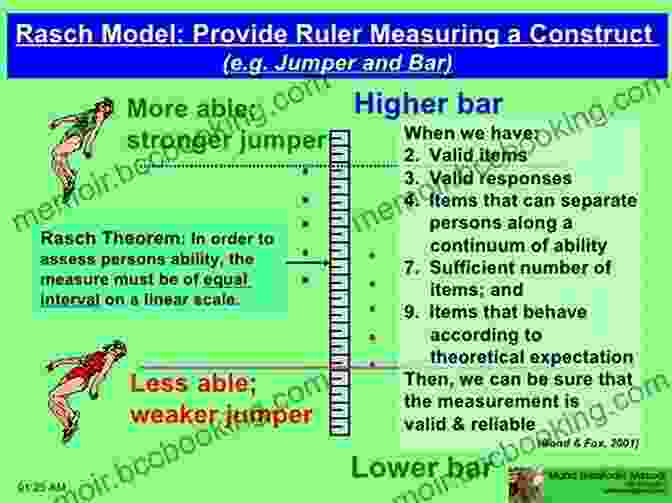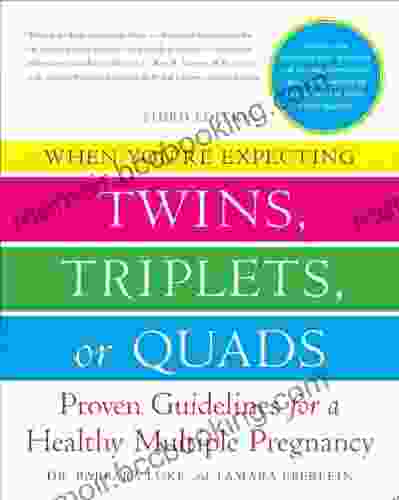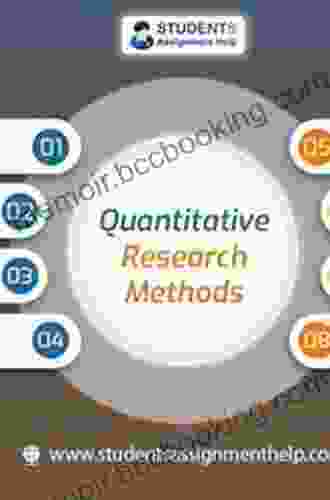Rasch Measurement Applications in Quantitative Educational Research: Unlocking Advanced Insights

In the realm of quantitative educational research, Rasch measurement stands as a powerful tool for unlocking advanced insights and making informed decisions. This comprehensive guide delves into the multifaceted applications of Rasch measurement, empowering researchers with the knowledge and skills to enhance their research endeavors.
5 out of 5
| Language | : | English |
| File size | : | 14953 KB |
| Text-to-Speech | : | Enabled |
| Screen Reader | : | Supported |
| Enhanced typesetting | : | Enabled |
| Word Wise | : | Enabled |
| Print length | : | 445 pages |
What is Rasch Measurement?
Rasch measurement is a psychometric method developed by Georg Rasch in the 1960s. It is based on the idea that the probability of a person answering a question correctly is a function of the person's ability and the difficulty of the question. Rasch models can be used to estimate the ability of individuals and the difficulty of items, as well as to assess the fit of data to the Rasch model.
Applications in Quantitative Educational Research
Rasch measurement has a wide range of applications in quantitative educational research, including:
- Test Development: Rasch models can be used to develop tests that are reliable and valid. By ensuring that the items on a test are of equal difficulty and that the test as a whole is a good measure of the construct being measured, Rasch measurement can help researchers to create tests that are fair and accurate.
- Item Analysis: Rasch models can be used to analyze the difficulty of individual items on a test. This information can be used to identify items that are too easy or too difficult, as well as to improve the overall quality of a test.
- Person Measurement: Rasch models can be used to estimate the ability of individuals on a test. This information can be used to make decisions about placement, instruction, and other educational interventions.
- Group Comparisons: Rasch models can be used to compare the abilities of different groups of individuals. This information can be used to identify differences between groups, as well as to assess the effectiveness of educational interventions.
- Model Fit: Rasch models can be used to assess the fit of data to the Rasch model. This information can be used to identify problems with a test or with the data collection process.
Benefits of Using Rasch Measurement
There are many benefits to using Rasch measurement in quantitative educational research. These benefits include:
- Enhanced Measurement Precision: Rasch measurement provides more precise estimates of ability and difficulty than traditional methods. This is because Rasch models take into account the difficulty of the items on a test, as well as the ability of the individuals taking the test.
- Increased Validity: Rasch measurement can help to ensure that tests are valid measures of the constructs they are intended to measure. This is because Rasch models take into account the underlying structure of the data, which can help to identify items that are not measuring the intended construct.
- Improved Fairness: Rasch measurement can help to ensure that tests are fair to all individuals. This is because Rasch models take into account the difficulty of the items on a test, which can help to prevent individuals from being penalized for taking a more difficult test.
- Simplified Data Analysis: Rasch measurement can simplify the process of data analysis. This is because Rasch models provide a straightforward way to estimate ability and difficulty, as well as to assess the fit of data to the Rasch model.
Rasch measurement is a powerful tool that can be used to enhance the quality of quantitative educational research. By providing more precise estimates of ability and difficulty, increasing validity, improving fairness, and simplifying data analysis, Rasch measurement can help researchers to make more informed decisions about educational issues.
If you are interested in learning more about Rasch measurement, there are a number of resources available online. The Rasch Measurement Society website is a good place to start.
References
- Rasch, G. (1960). Probabilistic models for some intelligence and attainment tests. Copenhagen: Danmarks Paedagogiske Institut.
- Wright, B. D., & Masters, G. N. (1992). Rating scale analysis: Rasch measurement. Chicago: MESA Press.
- Bond, T. G., & Fox, C. M. (2015). Applying the Rasch model: Fundamental measurement in the human sciences. London: Routledge.

5 out of 5
| Language | : | English |
| File size | : | 14953 KB |
| Text-to-Speech | : | Enabled |
| Screen Reader | : | Supported |
| Enhanced typesetting | : | Enabled |
| Word Wise | : | Enabled |
| Print length | : | 445 pages |
Do you want to contribute by writing guest posts on this blog?
Please contact us and send us a resume of previous articles that you have written.
 Book
Book Novel
Novel Page
Page Chapter
Chapter Text
Text Story
Story Genre
Genre Reader
Reader Library
Library Paperback
Paperback E-book
E-book Magazine
Magazine Newspaper
Newspaper Paragraph
Paragraph Sentence
Sentence Bookmark
Bookmark Shelf
Shelf Glossary
Glossary Bibliography
Bibliography Foreword
Foreword Preface
Preface Synopsis
Synopsis Annotation
Annotation Footnote
Footnote Manuscript
Manuscript Scroll
Scroll Codex
Codex Tome
Tome Bestseller
Bestseller Classics
Classics Library card
Library card Narrative
Narrative Biography
Biography Autobiography
Autobiography Memoir
Memoir Reference
Reference Encyclopedia
Encyclopedia Atsons
Atsons Armand Lauffer
Armand Lauffer Arizona Bushman
Arizona Bushman Asali Solomon
Asali Solomon Anne E White
Anne E White Ann Vigola Anderson
Ann Vigola Anderson Axie Oh
Axie Oh Autumn Jordon
Autumn Jordon Arnold Steenbeek
Arnold Steenbeek Aylen Gaylord
Aylen Gaylord Anna Claybourne
Anna Claybourne Alex Bellos
Alex Bellos Aristophanes
Aristophanes Anita Bakshi
Anita Bakshi Albert B Ulrich Iii
Albert B Ulrich Iii Asumiko Nakamura
Asumiko Nakamura Annabel Abbs
Annabel Abbs Archie Kalokerinos
Archie Kalokerinos Ashley Rickards
Ashley Rickards Aurora Levins Morales
Aurora Levins Morales
Light bulbAdvertise smarter! Our strategic ad space ensures maximum exposure. Reserve your spot today!
 Eric HayesFollow ·13.9k
Eric HayesFollow ·13.9k Gabriel Garcia MarquezFollow ·11.8k
Gabriel Garcia MarquezFollow ·11.8k Jackson BlairFollow ·16.9k
Jackson BlairFollow ·16.9k Austin FordFollow ·10.4k
Austin FordFollow ·10.4k Yasushi InoueFollow ·16.2k
Yasushi InoueFollow ·16.2k Bret MitchellFollow ·13.9k
Bret MitchellFollow ·13.9k Dean CoxFollow ·2.5k
Dean CoxFollow ·2.5k Jacob HayesFollow ·16.2k
Jacob HayesFollow ·16.2k

 Brayden Reed
Brayden ReedTeach Your Child They Have No Self Worth And They Will...
By Dr. Jane Doe ...

 Shawn Reed
Shawn ReedUnveiling Centuries of Tradition: History of Childbirth...
Journey into the heart of the...

 Brady Mitchell
Brady MitchellProven Guidelines For Healthy Multiple Pregnancy
Congratulations on your...

 Dylan Mitchell
Dylan MitchellHarness the Power of Sleep for Optimal Health and...
In the fast-paced,...

 Herman Melville
Herman MelvilleAlexander Hamilton: The Revolutionary Who Shaped...
Alexander Hamilton was a...
5 out of 5
| Language | : | English |
| File size | : | 14953 KB |
| Text-to-Speech | : | Enabled |
| Screen Reader | : | Supported |
| Enhanced typesetting | : | Enabled |
| Word Wise | : | Enabled |
| Print length | : | 445 pages |














